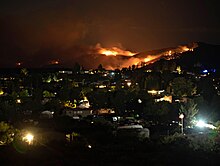Wildfires in 2021
| 2021 wildfire season | |
|---|---|
| Date(s) | January–December 2021 |
| Season | |
← 2020
2022 → | |
The 2021 wildfire season involves wildfires on multiple continents. Even at halfway through the calendar year, wildfire seasons were larger than in previous history, with increased extreme weather caused by climate change (such as droughts and heat waves) strengthening the intensity and scale of fires.[1]
Below is a partial list of articles on wildfires from around the world in the year 2021.
Africa
- Algeria
- South Africa

Asia
- Cyprus
- India
- Israel
- Russia

- Turkey
Europe
- France
- Greece
- Italy
North America
This section needs to be updated. (November 2021) |
As of September 14, 2021, the National Interagency Fire Center (NIFC) reported that 44,647 wildfires in the United States had burned 5.6 million acres of land.[4] Similarly, the Canadian Interagency Forest Fire Centre (CIFFC) announced that 6,317 wildfires burned 10.34 million acres.[5] Initially, the NIFC declared that the United States and Canada had a preparedness level of 5, meaning it had the potential to exhaust national firefighting resources.[6] Due to the earliness and severity of the wildfire season, the United States and Canada were unable to provide each other with aid as in previous years.[7] However, by September 20, 2021, the national preparedness level was reduced to 4 and 1 for the United States and Canada, respectively.[8]
In April 2021, the North American wildfire season was predicted to be severe due to record drought conditions and high spring temperatures in the West.[9] In May, more than 75% of the western United States experienced drought conditions, with 21% of these conditions being deemed as "exceptional drought", which is the most extreme level of drought.[10] These extreme conditions result in a lack of moisture on the ground that is imperative for combating wildfires.[11] In Arizona, there were 311 early wildfires in the first four months of the year, compared to 127 in the same period in 2020.[12]
In July 2021, haze from West Coast fires was affecting East Coast cities,[13][14] and particulate pollution caused unhealthy air quality in New Hampshire.[15]
In Montana, evacuation orders had displaced around 600 people by early August.[16]
On October 21, the national preparedness level was lowered to 1 (indicating minimal fire activity).[8] By November 5, a total of 48,725 wildfires had burned more than 6.5 million acres across the United States, according to the National Interagency Fire Center (NIFC).[8]
- Canada


- Mexico
- United States
- 2021 Arizona wildfires
- 2021 California wildfires
- 2021 Colorado wildfires
- 2021 Idaho wildfires
- 2021 Kansas wildfires
- 2021 Minnesota wildfires
- 2021 Montana wildfires
- 2021 New Mexico wildfires
- 2021 Oregon wildfires
- 2021 Texas wildfires
- 2021 Utah wildfires
- 2021 Washington wildfires
South America
Oceania
See also
References
- ^ Times, The New York (2021-07-21). "Fire, floods, dead fish: Climate change fuels extreme weather, with no 'return to normal.'". The New York Times. ISSN 0362-4331. Retrieved 2021-07-23.
- ^ "Cyprus: Nations send help to tackle worst wildfire in decades". BBC. 4 July 2021.
- ^ "EuropeGreece evacuates more villages as forest fire spreads to Attica region". Reuters. 20 May 2021.
- ^ "National Fire News | National Interagency Fire Center". www.nifc.gov. Retrieved 2021-09-14.
- ^ "National Fire Situation Report". Canadian Interagency Forest Fire Centre. Retrieved September 26, 2021.
{{cite web}}: CS1 maint: url-status (link) - ^ National Interagency Fire Center (2021). "Fire Information". www.nifc.gov. Retrieved 2021-09-14.
{{cite web}}: CS1 maint: url-status (link) - ^ McCarten, James (August 4, 2021). "Early wildfire season makes Canada-U.S. resource-sharing impossible: Ottawa". Toronto Sun. Retrieved 2021-09-27.
{{cite news}}: CS1 maint: url-status (link) - ^ a b c Center for Disaster Philanthropy (November 10, 2021). "2021 North American Wildfire Season". disasterphilanthropy.org. Retrieved 2021-11-20.
{{cite web}}: CS1 maint: url-status (link) - ^ Matthew Cappucci (April 2, 2021). "'Record-breaking' temperatures to engulf Southwest, with 'critical' fire weather conditions possible". Washington Post.
- ^ Puleo, Mark (May 5, 2021). "AccuWeather forecasters predict another bad fire season". AccuWeather.
{{cite web}}: CS1 maint: url-status (link) - ^ Jacobo, Julia (May 17, 2021). "Climate change may be causing an early start to fire season in the West, experts say". ABC News. Retrieved 2021-09-27.
{{cite web}}: CS1 maint: url-status (link) - ^ Simon Romero (April 30, 2021). "'Firefighters Out There in the Snow': Wildfires Rage Early in Parched West". The New York Times.
- ^ McGrath, Cassie (2021-07-26). "Air Quality Action Day in effect: Haze and smoky odor in Massachusetts sky on Monday due to Western and Canadian wildfires". masslive. Retrieved 2021-07-27.
- ^ Garrity, Kelly (July 26, 2021). "Wildfires on West Coast Prompt 'Unhealthy' Air Quality Alert in Mass". NBC Boston. Retrieved 2021-07-27.
{{cite web}}: CS1 maint: url-status (link) - ^ Jennifer Crompton (July 26, 2021). "Air quality action days declared in New Hampshire because of wildfire smoke". Manchester, New Hampshire: WMUR.
- ^ "Montana wildfires: 600 people displaced from homes; Boulder 2700 fire top priority". Missoula Current. 2021-08-04. Retrieved 2021-09-27.
